|
| |
Motorcycle Exhibits
|
| |
|
|
The
BSA C10L was a pre unit single cylinder motorcycle made between 1953
and 1957. The C10 has been launched in 1939 before the second world war
and in 1940 over 500 of them were ordered in military specification for
use in India. Both types of C10 had the same 249cc overhead valve
engine in a modern frame but the 10L has good suspension, more
efficient brakes and a more comfortable seat. A single seat was always
fitted as standard. Built in 1956 this C10L has a 12hp 4 stroke engine,
a cruising speed of 55mph with a top speed of 65mph.
|
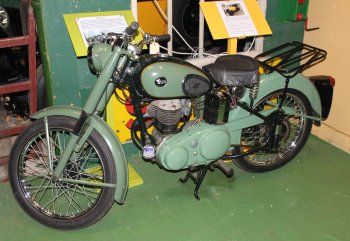
|
|
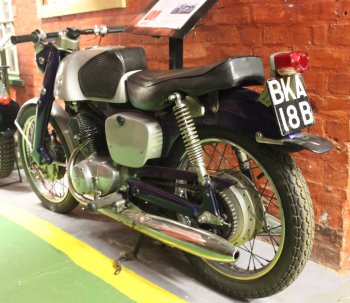
|
The
Honda CB92 arrived on the scene in 1959 like a stick of dynamite. An
enormous amount of research had gone into the development of this twin
cylinder 125cc motorcycle. If anyone wonders how Honda rose to dominate
the motorcycle world so rapidly, over half a century ago, the CB92
provides the perfect illustration. It has an electric start, cast iron
barrell and a one piece cylinder head. It delivers around 15hp at a
dizzy 10,000rpm, has 4 gears and a top speed of around 75mph.
The twin leading shoe brakes were so good they were later fitted to
racing bikes with four times the engine size of this model Honda. It
came in Bright Red or Dark Blue.
The motorcycle press hailed it as a brilliant little motorcycle:
Handsome, fast (for its capacity), beautifully engineered and well
equipped. When it was launched the supersport wasn't merely the fastest
125cc bike around it could also embarrass many much larger machines on
both road and track.
|
|
The
Honda Cub was classed as a motorcycle so it was only in 1966 when the
first Japanese moped was introduced to Britain - the Honda P50. The
four stroke engine ran inside the rear wheel and gave it 1.2hp and a
top speed of 24mph. 25,000 were imported into Britian between 1966 and
1968 and were available in Sky Blue, Scarlet or Charcoal Grey.
"A little Honda lets you enjoy life more"
"It's NEW, it's Honda and only costs 49 guineas"
|
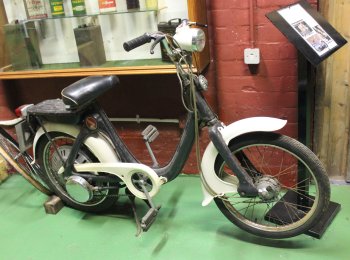
|
|
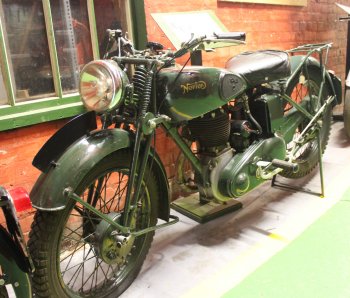
|
In
1902 the company, founded by James Norton, began manufacturing Nortons
in Birmingham. It sold to both the British Ministry of Munitions and
the Russian Army in World War 1. Production of the 13H started in
1932. It had a single cylinder 490cc side valve engine. The H denotes
the home model as distinct to the colonial export model. Norton was one
of the main suppliers to the Army before and during WW2 with a total of
nearly 100,000 produced. They also supplied to the commonwealth forces
of the Australian, New Zealand, Indian and Canadian Armies. Military
motorcycles left the factory in Army Service Green, Khaki Green, Olive
Green or Khaki Brown depending on the colour in production at the time.
After the end of the hostilities in 1945 there were many thousands of
Norton model 16H motorcycles all over the world. Some continued in use
by British and Commonwealth armed forces until the late 1950's. Many
were sold off to other armed forces including Dutch, Greek and more.
The remainder were sold to dealers and converted for civilian use. One
London dealer had 200 for sale at £94 10s each.
|
|
1947
600c Scott Flying Squirrel. This is the later Scott in our collection.
They were popular because of their early TT successes and from 1914 -
1918 dispatch riders volunteering for war service were allowed to use
their own motorcycles. After the first World War production
restarted and in the 1920's Scott introduced the Squirrel, which had a
slightly smaller 486cc engine, but with aluminium pistons produced even
more power. It was followed by the Super Squirrel and Flying Squirrel
with revised engines of 500cc and 600cc.
Shortly after the end of WW2 the flying Squirrel was relaunched with
500cc or 600cc engines. They were even heavier than the pre-war
versions and expensive for the performance they offered, sales were
dissapointing.
The company went into liquidation in 1950, but an enthusiast, Matt
Holder, bought the parts and continued to build the same model in his
workshop into the 1960's.
|
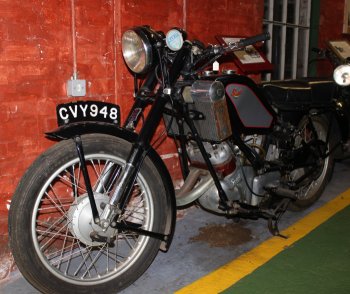
|
|
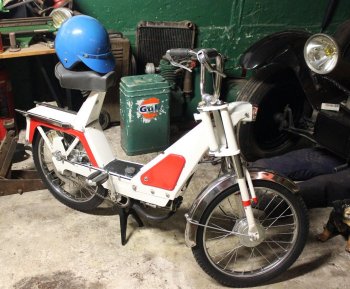
|
The
6000 model was very different to motorised bicycles that Solex usually
made. Instead of using an engine that fits above the front wheel it
lies under the bottom bracket. It is turbine cooled and had a drive
shaft transmission, so it doesn't need a chain.
It has a 49cc cylinder and comes with a rear disc brake. Running up to 30 miles on a litre of fuel at a speed of up to 25mph.
Our 1972 model has telescopic forks. Mopeds under 50cc can still be ridden by 14 year olds in France!
|
|
| |
|
|
|
|
|

